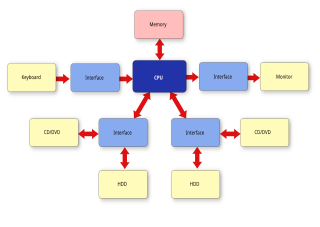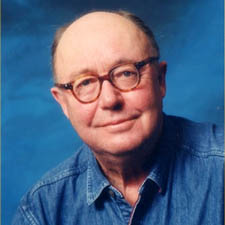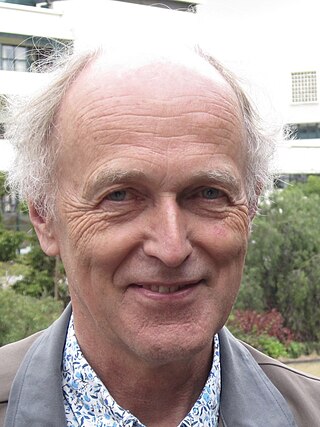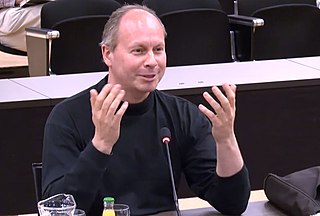Roelf Johannes (Roel) Wieringa (born 1952) is a Dutch computer scientist who was a professor of Information Systems at the University of Twente, specialized in the "integration of formal and informal specification and design techniques". [1] [2]
Roelf Johannes (Roel) Wieringa (born 1952) is a Dutch computer scientist who was a professor of Information Systems at the University of Twente, specialized in the "integration of formal and informal specification and design techniques". [1] [2]
Wieringa received his MSc in 1978 at the University of Groningen, Faculty of Mathematics, for the thesis "Generatieve Grammatika's en Bijbehorende Analyseprocedures voor Natuurlijke talen" (Generative Grammars and Their Analysis procedures for NaturalLanguages". He received his MA in 1987 at the University of Amsterdam, Faculty of Philosophy [3] for the thesis Machine intelligence and Explication, and his PhD in 1990 at the Vrije Universiteit Amsterdam, under supervision of Reinder Pieter van de Riet for the thesis Algebraic Foundations for Dynamic Conceptual Models. [4]
After finishing his PhD, he continued to work at the Faculty of Mathematics and Computer Science of the Vrije Universiteit. In 1998 he joined the Department of Computer Science of the University of Twente as Professor of Information Systems. [5] From 2006 to 2011 he was Scientific Director of the School of Information and Knowledge Systems (SIKS), and from 2009 to 2012 he headed the computer science department at the University of Twente.
Circa 1996, Wieringa and Frank Dehne wrote the Toolkit for Conceptual Modeling, for Wieringa's conceptual modeling courses and book, Requirements Engineering: Frameworks for Understanding. [6]
Wieringa has been Associate Editor in Chief of the IEEE Software journal from 2004 to 2007, and was member of the editorial board of the International Journal of Business Information Systems, the Journal of Software and Systems Modeling , and the Requirements Engineering Journal.
In 2019, Wieringa retired from academia, and now works and blogs at The Value Engineers, which was founded in 2017 with Jaap Gordijn and Dan Ionita. [2] [7]

The engineering cycle is a framework used in Design Science for Information Systems and Software Engineering, proposed by Roel Wieringa in his book "Design Science Methodology for Information Systems and Software Engineering". [8]
The engineering cycle consists of:
The design cycle consists of the first 3 tasks of the engineering cycle: investigation, design, and validation.
The engineering and design cycles do not prescribe a mandatory, rigid sequence of activities. Moreover, they are often applied recursively for sub-problems of the main research objective.
The engineering cycle and the design cycle are often applied in several iterations (hence “cycle”). In such a case, the evaluation may become the investigation part of the next engineering cycle.
According to the Design science methodology of (Wieringa, 2014), [8] validation is part of the design cycle. It involves checking if the designed artifacts support the initial assumptions. It is executed in a theoretical, “laboratory” environment; such as through discussions and interviews with practitioners and experts. Validation is executed before the implementation in practice.
On the other hand, evaluation is executed after the implementation in practice of the designs. It involves analyzing the behavior, effects, and impact of the designed artifacts in practice, in the field. In our case, this meant implementation and analysis of the designs in actual, industry IT projects.
Stefan Morcov proposes a parallel between these 2 activities and a similar framework, the Technology Readiness Level (TRL) model. [9] The TRL model was proposed by NASA and is currently also widely applied in the European Union's research programs such as Horizon. Thus, validation leads to TRL level 4 - “Technology validated in a laboratory environment”; while evaluation leads to a TRL level 6 - “Technology demonstrated in a relevant environment”. [10] [11]
Books, a selection
Articles, a selection: [12] [13]
A modeling language is any artificial language that can be used to express data, information or knowledge or systems in a structure that is defined by a consistent set of rules. The rules are used for interpretation of the meaning of components in the structure Programing language.

In systems engineering, information systems and software engineering, the systems development life cycle (SDLC), also referred to as the application development life cycle, is a process for planning, creating, testing, and deploying an information system. The SDLC concept applies to a range of hardware and software configurations, as a system can be composed of hardware only, software only, or a combination of both. There are usually six stages in this cycle: requirement analysis, design, development and testing, implementation, documentation, and evaluation.
Peter Pin-Shan Chen is a Taiwanese American computer scientist. He is a (retired) distinguished career scientist and faculty member at Carnegie Mellon University and Distinguished Chair Professor Emeritus at LSU. He is known for the development of the entity–relationship model in 1976.

A system architecture is the conceptual model that defines the structure, behavior, and more views of a system. An architecture description is a formal description and representation of a system, organized in a way that supports reasoning about the structures and behaviors of the system.
The Toolkit for Conceptual Modeling (TCM) is a collection of software tools to present specifications of software systems in the form of diagrams, tables, trees, and the like. TCM offers editors for techniques used in Structured Analysis as well as editors for object-oriented (UML) techniques. For some of the behavior specification techniques, an interface to model checkers is offered. More in particular, TCM contains the following editors.

A design rationale is an explicit documentation of the reasons behind decisions made when designing a system or artifact. As initially developed by W.R. Kunz and Horst Rittel, design rationale seeks to provide argumentation-based structure to the political, collaborative process of addressing wicked problems.
Market engineering comprises the structured, systematic and theoretically founded procedure of analyzing, designing, introducing and also quality assuring of markets as well as their legal framework regarding simultaneously their market mechanisms and trading rules, systems, platforms and media, and their business models. In this context, term market stands for a set of rules defining the exchange of information between participants to conduct transactions at minimized cost. Market Engineering borrows concepts and methods from Economics, particularly, Game Theory, and Mechanism Design concepts, but also borrows concepts from Finance, Information Systems and Operations Research. It finds particular application in the context of electronic market platforms.
Design science research (DSR) is a research paradigm focusing on the development and validation of prescriptive knowledge in information science. Herbert Simon distinguished the natural sciences, concerned with explaining how things are, from design sciences which are concerned with how things ought to be, that is, with devising artifacts to attain goals. Design science research methodology (DSRM) refers to the research methodologies associated with this paradigm. It spans the methodologies of several research disciplines, for example information technology, which offers specific guidelines for evaluation and iteration within research projects.

Roger Michael Needham was a British computer scientist.

Jean Leonardus Gerardus (Jan) Dietz is a Dutch Information Systems researcher, Professor Emeritus of Information Systems Design at the Delft University of Technology, known for the development of the Design & Engineering Methodology for Organisations. and his work on Enterprise Engineering.
Business semantics management (BSM) encompasses the technology, methodology, organization, and culture that brings business stakeholders together to collaboratively realize the reconciliation of their heterogeneous metadata; and consequently the application of the derived business semantics patterns to establish semantic alignment between the underlying data structures.
The triune continuum paradigm is a paradigm for general system modeling published in 2002. The paradigm allows for building of rigorous conceptual frameworks employed for systems modeling in various application contexts.
Jacobus Nicolaas (Sjaak) Brinkkemper is a Dutch computer scientist, and Full Professor of organisation and information at the Department of Information and Computing Sciences of Utrecht University.
In software engineering, a software development process or software development life cycle (SDLC) is a process of planning and managing software development. It typically involves dividing software development work into smaller, parallel, or sequential steps or sub-processes to improve design and/or product management. The methodology may include the pre-definition of specific deliverables and artifacts that are created and completed by a project team to develop or maintain an application.
Johannes Cornelis (Hans) van Vliet is a Dutch computer scientist and Professor Emeritus of Software Engineering at the Vrije Universiteit Amsterdam, known for his work in quantitative aspects of software engineering.
Henderik Alex (Erik) Proper is a Dutch computer scientist, an FNR PEARL Laureate, and a senior research manager within the Computer Science (ITIS) department of the Luxembourg Institute of Science and Technology (LIST). He is also adjunct professor in data and knowledge engineering at the University of Luxembourg. He is known for work on conceptual modeling, enterprise architecture and enterprise engineering.

Christopher (Chris) Verhoef is a Dutch computer scientist, and Professor of Computer Science at the Vrije Universiteit in Amsterdam.

Reinder Pieter (Reind) van de Riet was a Dutch computer scientist and Emeritus Professor Information Systems at the Vrije Universiteit Amsterdam, known for the development of COLOR-X, a linguistically-based event modeling language for object modeling.
Giancarlo Guizzardi is a Brazilian–Italian computer scientist specializing in conceptual modeling, enterprise modeling, applied ontology and ontology-driven information systems. He is a professor in the University of Twente in The Netherlands and a senior researcher and founding member of the Ontology & Conceptual Modeling Research Group (NEMO) in Vitoria, Brazil.
Mariëlle I. A. Stoelinga is a Dutch computer scientist based in the Netherlands. She is full professor of Risk Management for High Tech Systems in the Formal Methods & Tools Group at the University of Twente, Enschede, the Netherlands and holds a partial appointment as a full professor in the Software Science department at the Radboud University, Nijmegen. She is also director of Life Long Learning at the Faculty of Electrical Engineering, Mathematics and Computer Science, at the University of Twente.
{{cite book}}: CS1 maint: location missing publisher (link)